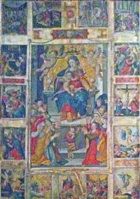

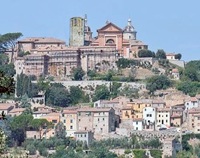
The original Duomo of Amelia, which was dedicated to San Lorenzo, was built in the 6th century, almost certainly outside the city walls.
According to a 14th century document, Bishop Pasquale (documented in 868-79) began the construction of a church that stood on the site of the present Duomo (at the highest point in the city). It had a baptistery opposite, as recorded in the inscription over the portal opposite, at the far left of the facade of Palazzo Vescovile. Bishop Pasquale translated the relics of SS Firmina and Olympias and those of St Himerius to this new church from Castellum Luchianum (which was probably near modern Lugnano in Teverino, some 10km west of Amelia) in the reign of Pope Adrian II (867-72).
The church was subsequently rebuilt on two occasions:
-
✴in 1245 after Emperor Frederick II had desecrated it in 1240 and destroyed the baptistery; and
-
✴in 1640-80, after a fire in 1629.
The ancient crypt was destroyed in this second rebuilding, when the new presbytery was built at the same level as the nave.
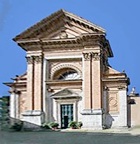
Interior


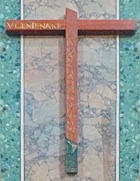
Cappella di San Giovanni Battista
A letter of 1480 from Pope Sixtus V to the Commune makes it clear that Giovanni Geraldini had recently founded this chapel (the 1st on the left). The inscriptions that now forms part of his monument in the chapel (see below) read: “CONSTRUIS ET GENERI ET TIBI GERALDINE IOHANNES PRAESUL APUD CALABROS HOC CATHACENSIS OPUS”, with the date 1476 below it. The likelihood is that this refers to both the monument and the chapel in the Duomo.
The papal letter makes it clear that the construction of the chapel had been linked to the establishment of an archdeaconate that was to be reserved for a member of the Geraldini family. This had given rise to local opposition, and had proceeded only after Sixtus IV had intervened in 1479 by creating Giovanni’s nephew, Camillo Geraldini as the first Archdeacon of Amelia. When Camillo died soon after, the post had past to his cousin, Agapito.
Funerary Monument of Giovanni Geraldini (1476)
The monument of Giovanni Geraldini was documented in the family chapel in San Francesco in 1662, and this is usually said to have been its original location. However, the composition includes a large relief of St John the Baptist, which suggests that it had originally been designed for this chapel. The surviving elements of it, which were clumsily recomposed in this chapel at an unknown date after 1916, are attributed to Agostino di Duccio. If the attribution is correct, it must have been designed before Agostino’s death in ca. 1481, some time before Giovanni’s death in 1488. It seems likely that it was designed, along with the chapel itself, in 1476.
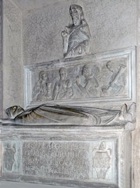
-
✴the relief of St John the Baptist mentioned above is at the apex of the composition;
-
✴a relief of the the Madonna and Child with three personifications of virtues is mounted on the wall below;
-
✴the effigy of Giovanni Geraldini lies on a sarcophagus that stands on the floor; and
-
✴the inscription reproduced above is on the front of the sarcophagus, with the date 1476 on the plinth below it.
The virtues to the sides of the Madonna and Child represent Faith and Hope: the figure of the Baby Jesus presumably represents the third Theological Virtue, Love. The third personification to the right, which disturbs the symmetry, represents the Cardinal Virtue, Fortitude.
Cappella dell' Assunta
This chapel is in the left transept.
Assumption of the Virgin (early 15th century)
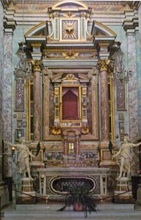
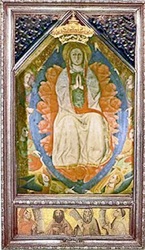
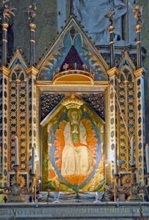
Usual location in left transept Altar to right of presbytery
The venerated altarpiece depicts the Virgin in a mandorla that is carried to Heaven by angels. It is usually covered and kept in the Cappella dell’ Assunta, but is displayed to the right of the presbytery (as illustrated above, on the right) for periods in May and August, when it features in annual processions. The predella depicts two prophets flanked by SS Bernard (on the left) and Bonaventure, both of whom championed the doctrine of the Assumption of the Virgin.
Scientific examination suggests that the panel was painted in the early 15th century. The earliest surviving documentary reference to the panel dates to 1573, when it was in a chapel that belonged to the Moriconi family. This suggests that it had been commissioned during the reign of Bishop Andrea Moriconi (1409-25). This rules out the sometimes alleged attribution to Duccio di Buoninsegna, and it is therefore more commonly attributed to the otherwise unknown Maestro dell’ Assunta di Amelia.
In 1703, after Amelia had survived the earthquake that devastated much of the surrounding area, the citizens sought papal approval for the coronation of the image. This was solemnly carried out in 1745.
Presbytery
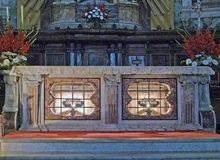
The relics of SS Firmina and Olympias, which had been moved from the old Duomo as the Emperor Frederick II approached, are now preserved under the high altar (1648).
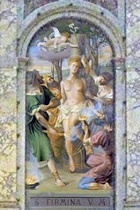
Cappella di San Giuseppe
This chapel in the right transept originally belonged to the Confraternita del Corpo di Christo, when it was dedicated as the Cappella del Santissimo Sacramento.
Last Supper (1538)
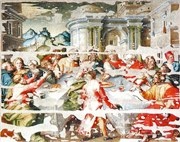
This damaged altarpiece is on the left wall. The Confraternita del Corpo di Christo commissioned it from Giovanni Francesco Perini. It is the only one of his five documented works to survive.
Vestibule to Cappella Farrattini

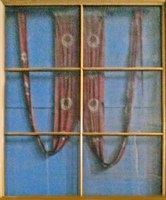
Cappella Farrattini, the funerary chapel of the Farrattini family, is the 2nd chapel on the right. Its vestibule contains two Turkish standards that were probably captured at the Battle of Lepanto in 1571. Pirro Geraldini and Stefano Cansacchi, both of whom came from prominent families in Amelia, are known to have served in the papal victory at Lepanto.
Cappella Mandosi
This chapel (the 1st on the right) belonged to the family of Ruggero Mandosi, who was Bishop of Amelia for forty years until his death in 1484.
Monument of Bishop Ruggero Mandosi (ca. 1484)
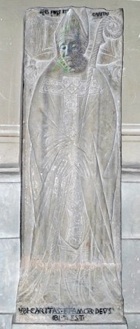
-
✴the inscription on the pillow, to either side of the mitre, reads “SPES: FIDES: CARITAS” (Hope: Faith: Charity); and
-
✴the inscription under the bishop’s feet reads “Ubi Caritas et Amor, Deus ibi est” (Where charity and love are, God is there” (which is from a hymn that is usually used on the feast of the Last Supper).
The relief is sometimes attributed to Agostino di Duccio, although the last documentary reference to him is in 1481, some three years before the death of Bishop Mandosi. It is of course possible that the monument was commissioned while Bishop Mandosi was still alive. It is also possible that the reliefs of Virtues now incorporated into the monument to Giovanni Geraldini (above) came from this monument.
Altarpieces in the Duomo
Madonna of the Rosary (16th century)
Madonna and Child with saints (1639)
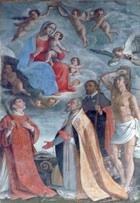
St Liborius (1675)
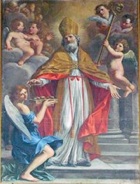
Art from the Duomo
Madonna and Child (15th century)
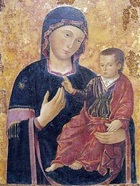
[Previously in the right transept: where is it now?]
Crucifixion with SS Firmina and Olympias (1557)
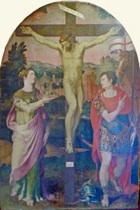
Visitation (17th century)
This panel, which came from San Francesco, is attributed to Bartolomeo Barbiani. [Previously in the right transept: where is it now?]
Roman Artefacts from the Duomo
Funerary Altar (1st century AD)

The inscription (CIL XI 4522) on the front of the altar commemorates Sessia Labionilla, who was probably the daughter of a freedman. In the relief along the bottom, Bacchus rides in procession on a donkey and (to the right) offers food to a panther.
